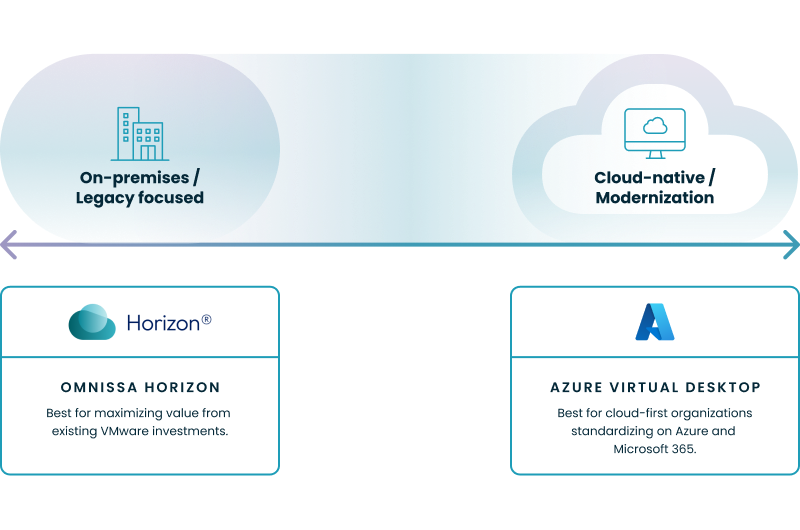Azure Virtual Desktop vs Horizon
This guide provides a straightforward comparison to help you determine which VDI solution best aligns with your enterprise’s technical requirements and business goals.
NerdioCon 2026: Don’t miss out! Lock in your spot early and save — this is the IT event of the year.
Register Now
This guide provides a straightforward comparison to help you determine which VDI solution best aligns with your enterprise’s technical requirements and business goals.
Carisa Stringer | October 27, 2025
Choosing between Azure Virtual Desktop and Omnissa Horizon (formerly VMware Horizon) is a key strategic decision for IT leaders. This is not just a feature comparison; it’s a choice between a cloud-native service fully integrated into the Microsoft Azure ecosystem and a mature, hybrid-first platform designed for the VMware software-defined data center.
Disclaimer: Content referencing Omnissa products is based on public information from those company’s websites, current as of the last article update. For the latest product details and further inquiries, please consult the official Omnissa website.
The most significant distinction between Azure Virtual Desktop (AVD) and Omnissa Horizon lies in their fundamental architecture. This difference dictates everything from deployment and management overhead to infrastructure dependencies and overall flexibility. The diagram below illustrates this core architectural split, showing how AVD operates as a cloud-native service versus Horizon's more traditional, component-based model.

The control plane is the "brain" of a virtual desktop infrastructure (VDI) solution, handling user connections, authentication, and resource allocation. How it's managed is a primary differentiator.
Each platform is optimized for a different primary environment, which influences its suitability for your existing infrastructure strategy.
Understanding the ecosystem each platform relies on is critical for assessing integration and management complexity.
Beyond architecture, the specific features related to user experience, OS support, and IT management directly impact performance and operational efficiency. A direct comparison highlights how each platform addresses the core needs of a virtual desktop environment. The table below summarizes these key distinctions at a glance.
| Azure Virtual Desktop (AVD) | Omnissa Horizon 8 2506 | |
|---|---|---|
| Display Protocol | Modern RDP, optimized for the Azure global network and Microsoft 365 integrations. | Blast Extreme, engineered for high-fidelity graphics and a rich user experience. |
| Unique OS Support | Exclusive access to Windows 10/11 Enterprise multi-session for significant cost-efficiency. | Broad support for various Windows client and server operating systems for legacy compatibility. |
| Management Focus | Simplified service management, focusing on user-facing elements like images and applications. | Centralized ecosystem management, requiring deep expertise in the VMware infrastructure stack. |
The display protocol determines the quality and responsiveness of the end-user experience. The protocol's performance directly impacts how seamless the virtual desktop feels on the user's endpoint, whether it's a thin client, a laptop, or a mobile device.
The choice of operating system has significant implications for both cost and user experience.
The day-to-day management experience and the skills required of your IT team vary significantly between the two platforms.
Analyzing the Total Cost of Ownership (TCO) requires looking beyond simple licensing to include infrastructure, operational overhead, and potential indirect costs. The financial models for AVD and Horizon reflect their different architectural foundations, and the table below summarizes the primary cost factors for each platform.
| Azure Virtual Desktop (AVD) | Omnissa Horizon 8 2506 | |
|---|---|---|
| Licensing Structure | Control plane access is included with many existing Microsoft 365/Windows licenses. | Subscription-based, per-user licensing (named or concurrent). |
| Primary Cost Model | 100% Operational Expenditure (OpEx), based on Azure consumption. | Primarily Capital Expenditure (CapEx) for on-premises; shifts to OpEx in the cloud. |
| Key Cost Drivers | Consumption of Azure VMs, storage, and networking. | Per-user license fees plus underlying infrastructure costs (hardware or IaaS). |
This step-by-step wizard tool gives you the total cost of ownership for AVD in your organization.
The right VDI platform is the one that best aligns with your organization's existing infrastructure, strategic goals, and workforce needs. Rather than being universally "better," each solution excels in different scenarios.

AVD is the ideal choice for organizations strategically aligning with a cloud-native model. Consider AVD if you aim to:
Omnissa Horizon excels for enterprises that need to leverage existing investments or require deep control over their VDI stack. Consider Horizon if you need to:
Adopting a modern platform like AVD reduces infrastructure burden, but managing a large-scale cloud VDI environment introduces new operational complexities. Addressing these challenges is key to realizing the full value of your move to the cloud.
While Microsoft manages the AVD back-end, your IT team is still responsible for several complex and time-consuming operational tasks. At an enterprise scale, these challenges include:
Nerdio Manager for Enterprise is a deployment, management, and automation platform that runs in your own Azure subscription on top of AVD and Windows 365. It addresses the native complexities of these platforms by adding a layer of enterprise-grade control and optimization.
See this demo to learn how you can optimize processes, improve security, increase reliability, and save up to 70% on Microsoft Azure costs.
See how you can optimize processes, improve security, increase reliability, and save up to 70% on Microsoft Azure costs.
The primary difference is their architectural model and environment. VMware Horizon is a virtual desktop infrastructure (VDI) solution that can be deployed on-premises in a private data center or in a public cloud, offering hybrid flexibility. Azure Virtual Desktop (AVD) is a cloud-native service that runs exclusively on the Microsoft Azure cloud, where Microsoft manages the VDI back-end infrastructure for you.
VMware Horizon is not being replaced; rather, the business unit responsible for it has been rebranded. In 2024, VMware's End-User Computing (EUC) division, which includes the Horizon product line, was sold to the private equity firm KKR and now operates as an independent company named Omnissa. The product continues as Omnissa Horizon.
Azure virtual machines are a core Infrastructure-as-a-Service (IaaS) component of the Microsoft Azure public cloud. VMware virtual machines run on the vSphere hypervisor, which is typically deployed on-premises in a private data center but can also run in certain public cloud environments. The choice depends on whether your strategy is cloud-native or centered on a private, software-defined data center.
The primary disadvantages of Azure Virtual Desktop are its exclusive dependency on the Microsoft Azure cloud, which may not suit hybrid or multi-cloud strategies. Additionally, it requires specific Azure expertise to manage effectively, and organizations must diligently manage cloud consumption with automation tools to prevent unpredictable or runaway costs.
Neither platform is universally "better"; the best choice depends entirely on your organization's specific needs and goals. If your strategy is to move to a cloud-native, OpEx-based model and reduce infrastructure management, Azure VMs are the better fit. If you have significant on-premises investments, require granular control, or have specific data sovereignty needs, VMware's vSphere-based VMs are often preferred.
"Azure" refers to Microsoft's entire public cloud platform, which offers hundreds of services, including compute, storage, and networking. "Horizon" is a specific application and desktop virtualization (VDI) product from Omnissa (formerly VMware). The more accurate comparison is between Azure Virtual Desktop (AVD), the VDI service on Azure, and Omnissa Horizon.



Customer story

Carisa Stringer
Head of Product Marketing
Carisa Stringer is the Head of Product Marketing at Nerdio, where she leads the strategy and execution of go-to-market plans for the company’s enterprise and managed service provider solutions. She joined Nerdio in 2025, bringing 20+ years of experience in end user computing, desktops-as-a-service, and Microsoft technologies. Prior to her current role, Carisa held key product marketing positions at Citrix and Anthology, where she contributed to innovative go-to-market initiatives. Her career reflects a strong track record in driving growth and adoption in the enterprise technology sector. Carisa holds a Bachelor of Science in Industrial Engineering from the Georgia Institute of Technology.